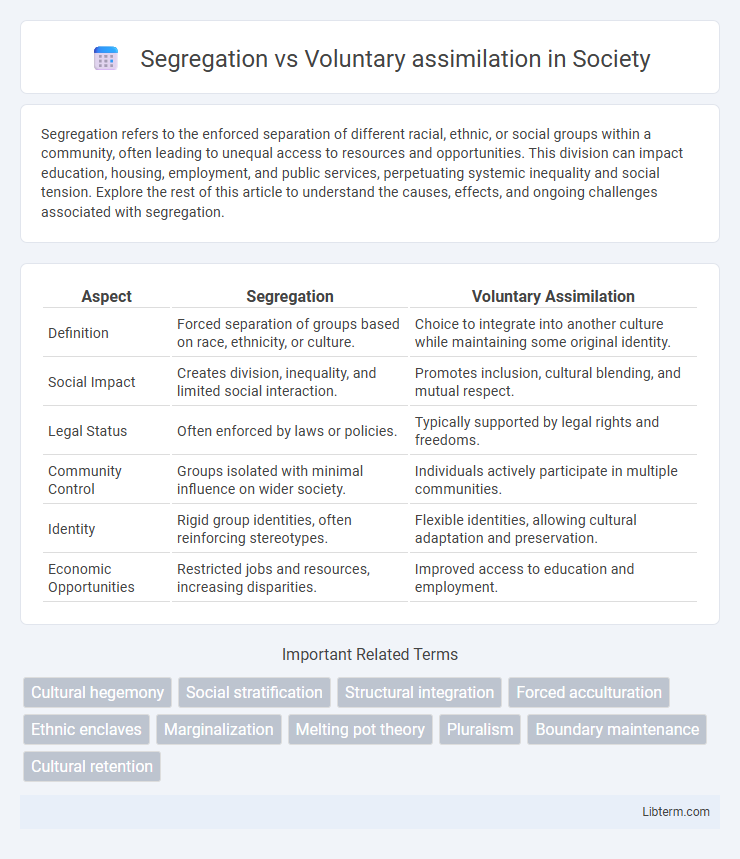Segregation refers to the enforced separation of different racial, ethnic, or social groups within a community, often leading to unequal access to resources and opportunities. This division can impact education, housing, employment, and public services, perpetuating systemic inequality and social tension. Explore the rest of this article to understand the causes, effects, and ongoing challenges associated with segregation.
Table of Comparison
| Aspect | Segregation | Voluntary Assimilation |
|---|---|---|
| Definition | Forced separation of groups based on race, ethnicity, or culture. | Choice to integrate into another culture while maintaining some original identity. |
| Social Impact | Creates division, inequality, and limited social interaction. | Promotes inclusion, cultural blending, and mutual respect. |
| Legal Status | Often enforced by laws or policies. | Typically supported by legal rights and freedoms. |
| Community Control | Groups isolated with minimal influence on wider society. | Individuals actively participate in multiple communities. |
| Identity | Rigid group identities, often reinforcing stereotypes. | Flexible identities, allowing cultural adaptation and preservation. |
| Economic Opportunities | Restricted jobs and resources, increasing disparities. | Improved access to education and employment. |
Understanding Segregation and Voluntary Assimilation
Segregation refers to the enforced separation of different groups based on characteristics such as race, ethnicity, or social status, often leading to unequal access to resources and opportunities. Voluntary assimilation occurs when individuals or groups adopt the cultural traits of another society by choice, facilitating social integration and reducing cultural barriers. Understanding these concepts highlights the contrast between imposed social divisions and self-directed cultural blending, which significantly impacts social cohesion and identity formation.
Historical Contexts of Segregation
Historical contexts of segregation are deeply rooted in institutional policies and social practices that systematically separated racial or ethnic groups, particularly evident in the Jim Crow era of the United States, apartheid in South Africa, and caste-based divisions in India. Segregation enforced legal and physical barriers that restricted access to resources, education, and political participation for marginalized communities, entrenching socioeconomic disparities. These systemic separations contrasted with voluntary assimilation, where individuals or groups chose to integrate culturally and socially into a dominant society, often motivated by economic opportunities or social acceptance.
Roots and Drivers of Voluntary Assimilation
Voluntary assimilation stems from individuals' desire to integrate into the dominant culture or society, driven by factors such as economic opportunities, social mobility, and the pursuit of educational advancement. Unlike segregation, which enforces separation based on race, ethnicity, or social status, voluntary assimilation involves conscious adaptation of language, customs, and identity to align with mainstream norms. Key drivers include intercultural interaction, policy incentives promoting inclusion, and the aspiration to reduce discrimination and increase acceptance within the host community.
Social Impacts of Group Separation
Segregation enforces physical and social boundaries that limit interaction, leading to reduced social cohesion and perpetuation of stereotypes within communities. Voluntary assimilation encourages integration and cultural exchange, fostering social unity and mutual understanding among diverse groups. Both approaches significantly impact societal dynamics, with segregation often resulting in inequality and voluntary assimilation promoting inclusivity and shared identity.
Cultural Identity: Preservation vs Integration
Segregation emphasizes the preservation of distinct cultural identities by maintaining separate social, educational, and community spaces, allowing minority groups to safeguard traditions, languages, and customs without external influence. Voluntary assimilation encourages integration into the dominant society, promoting shared values and behaviors while potentially diluting unique cultural markers in favor of broader social cohesion. The balance between preserving cultural heritage and achieving social integration reflects ongoing debates about identity retention versus adaptation within multicultural contexts.
Economic Consequences of Division and Assimilation
Segregation often leads to economic disparities by limiting access to resources, jobs, and quality education for marginalized groups, perpetuating poverty and inequality within divided communities. Voluntary assimilation, conversely, can enhance economic opportunities by integrating diverse skills and labor into a unified market, fostering innovation and upward mobility. However, the loss of cultural identity during assimilation may undermine social cohesion while improving collective economic outcomes.
Education Systems: Segregated vs Integrated Models
Segregated education systems often create disparities in resource allocation and academic outcomes, reinforcing social divides and limiting access to quality education for marginalized groups. Integrated models promote diversity and inclusion, enhancing critical thinking, cultural competence, and equitable opportunities by fostering interaction among students from varied backgrounds. Studies show integrated schools improve social cohesion and academic achievement, making voluntary assimilation through inclusive education a crucial strategy for addressing inequality.
Policy Approaches to Diversity Management
Segregation policies enforce the separation of diverse groups, limiting interaction and preserving distinct cultural or ethnic identities, often resulting in social fragmentation. Voluntary assimilation encourages individuals to adopt the dominant culture's norms and values willingly, promoting social cohesion but potentially diminishing minority cultural distinctiveness. Effective diversity management requires balancing these approaches to foster inclusion while respecting cultural differences through policies like multicultural education and anti-discrimination laws.
Psychological Effects on Individuals and Communities
Segregation often leads to feelings of isolation, reduced self-esteem, and heightened stress within individuals, while communities experience diminished social cohesion and economic disparities. Voluntary assimilation fosters integration and mutual understanding, promoting psychological well-being and stronger community bonds. However, loss of cultural identity during assimilation can cause identity conflicts and emotional distress for some individuals.
Future Trends in Social Cohesion
Future trends in social cohesion will likely see a shift as societies move away from segregation toward voluntary assimilation, fostering more inclusive communities and enhancing intercultural dialogue. Emerging technologies and global mobility contribute to increased interaction and blending of diverse cultural identities, supporting voluntary integration rather than enforced separation. Policy frameworks emphasizing equal opportunity and anti-discrimination measures will be crucial in promoting voluntary assimilation and preventing the resurgence of segregated social structures.
Segregation Infographic

 libterm.com
libterm.com